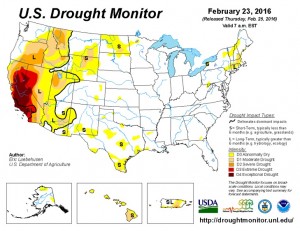The week that was, February 21-27, 2016
Posted on | February 27, 2016 | No Comments

Calgary’s Utilities and Environmental Protection Public Art Plan “Watershed+” used lights to track the rate of sewage treatment on the side of the city’s Forest Lawn wastewater lift system. Click on the rendering to hear engineers, artists and city planners discuss their desire to spark awareness of normally hidden infrastructure.
Oh, sh*t. — Calgary’s ‘poop palace’ wins wasteful spending award, Calgary Herald, 2/24/16
“We have the artists in the canal visit early on so they can understand the canal, and move with the canal, because the installations on water are technically very challenging.” — Donna Isaac, director of Scottsdale Public Art, A celebration of light, water and art, Arizona Republic, 2/23/16
“I listened very carefully and politely while you misstated the facts,” San Francisco Bay area Democratic congressman Jared Huffman to Tom Birmingham, general manager of the Central Valley’s Westlands Water District, Old tensions boil over once more in House hearings on California water, McClatchyDC, 2/24/16.
… urban water efficiency was the quiet achiever. — Managing drought: Learning from Australia, The Pacific Institute, 2/25/16
… an Australian level of agricultural drought response [in California] would have been fallowing about 4.5 million acres. — They never do the Australia analysis I want to see, On the Public Record, 2/26/16
“… February has been a bear, with no disrespect to bears.” — California State Water Resources Board Chair Felicia Marcus, Water conservation misses mark, San Francisco Chronicle, 2/25/16
“Across Africa alone, at least seven million people are without clean water as a result of El Nino weather.” — World Vision Ethiopia Country Director Sean Kerrigan, El Nino causing catastrophic water shortages, ReliefWeb, 2/22/16
The strong La Nina will result in much better harvest in 2016-17, but the situation will be known only by April-May. — Uncertainty over La Nina clouds growth prediction, The Times of India, 2/28/16
Rioters damaged this water canal and cut off the flow, and on top of that, these protesters were torching railroads, they were blocking highways. They cut a broad swath of destruction in Haryana state. Nineteen people were killed. The army was called in. And what they were rampaging over, David, is affirmative action and who’s entitled to it. One community, the Jat community, historically farmers, fought these pitched battles in the streets to secure government benefits. They view quotas for government jobs, for example, as the only tangible way to get any kind of influence to better themselves economically because they say, look, we’re down on our knees. — correspondent Julie McCarthy, Water in New Delhi partially restored after protestors sabotage source, NPR, 2/24/16
… since Delhi has no internal source of water other than a very small percentage from groundwater, experts say that creating a store for more than 2-3 days will be impractical. — Delhi Jal Board chief asks his men to prepare contingency plan, Times of India, 2/27/16

A stolen painting of the landmark Waldo Water Tower in Kansas City by local artist Patrick Saunders was returned to a public library this week with a remorseful note. Click on the image for more from KC’s local F0x4 News.
Bumps found on the Namib desert beetle turned out to be an ideal model for protrusions designed to promote condensation. — What a cactus, a beetle, and a pitcher plant can teach about harvesting water, Christian Science Monitor, 2/25/16
“I always tell myself that this is not right, to bathe and drink from the same water, but what can I do?” — Shadile Masulu, When water’s a dirty business, The [Johannesburg] Star, 2/24/16
“These plastic bags aren’t doing anyone any good in the long run.” — Maryland Delegate Brooke Lierman and co-sponsor of The Community Cleanup and Greening Act of 2016 , Ban the Bag, A Blue View, National Aquarium, 2/23/16
“It sounds kind of simple — ‘Let’s go count crabs.’ But if you don’t learn how to count crabs, you have a hard time trying to figure out how to manage them.” — Environment writer Tom Horton, Catching up with crabs in Beautiful Swimmers Revisited, Chesapeake Bay Journal, 2/25/16
“Anytime you’re dealing with an endangered species, as long as you see the numbers going up, that’s better than the alternative.” Holly Edwards, biologist, Florida Fish & Wildlife Conservation Commission — Record-breaking number of manatees counted during annual winter survey, Tampa Bay Times, 2/22/16
He called all the fish haddock, even if they weren’t. — Owner of New Bedford fishing business charged in sting in which agents posed as gangsters, The Boston Globe, 2/26/16
“The eastern U.S. has the highest diversity of salamanders in the world, and the introduction of this new pathogen is likely to be devastating.” — US Geological Survey researcher Katherine Richgels, Deadly amphibian fungus abroad threatens certain US regions, USGS, 2/22/16
There just aren’t that many people still spearing and that’s evident by the low number of shanties on the lake. — Winnebago system sturgeon spearing, Wisconsin Department of Natural Resources, 2/24/16
“… you spend about €400 on a tonne of grain, add a bit of water, heat it up, and in four years’ time sell if for €4,600 in Germany.”– Whiskey distiller John Teeling, “Key to success is simple, says “father” of whiskey renaissance, Belfast Telegraph, 2/25/16

Sixty-six year-old Clyde Aikau displays classic Hawaiian waterman style last Thursday at his last “Eddie” in O’ahu. Brother of the late lifeguard Eddie Aikau, he won the rarest and most elite of big wave competitions named after his brother in 1987. Fewer than a dozen Eddies have been held since then; the competition is only held on years with mythic big surf.
The highest reading was 300 times the legal limit glyphosate in drinking water in Germany … — Glyphosate weed killer found in German beers, study finds, Deutsche Welle, 2/25/16
Colorado is the only state that bans rain barrels and is one of just four states that restrict so-called rainwater harvesting, joined by Arizona, Oklahoma and Utah — Colorado rain-barrel bill passes House committee Monday, Denver Post, 2/22/16
“Who knows what the future holds?” — Pasadena city council member Margaret McAustin, How Pasadena wants to use recycled water, Pasadena Star-News, 2/23/16
“It was stunning, because it’s one of your bucket list things.” — diver and photographer Roger Hanson, Did El Nino bring this rare Pacific seahorse to Long Beach waters? , Long Beach Press-Telegram, 2/23/16

Record winter rain in Florida’s dry season has led to massive discharges of Lake Okeechobe water polluted by big sugar into coastal waters and the Everglades. Black tides are devastating the tourist season. To learn more click on the Earthjustice photo.
The lake fills up about three times faster than it can be drained. — Winter rains spur emergency action, South Florida Sun Sentinel, 2/23/16
“I think these studies really put the human fingerprint on Miami Beach’s hundred-million-dollar saltwater flooding problem, and really a lot of what’s going on in South Florida.” — Benjamin Strauss, Climate Central, Seas are rising faster than they have in 2,800 years, Washington Post, 2/22/16
… after water levels reached a foot above normal, public officials began to worry that the excess water was putting too much stress on the lake’s aging dike. Officials then made the decision to drain the lake out toward Florida’s coasts. There was one problem: Lake Okeechobee’s waters are toxic. — Polluted water is making its way toward Florida beaches, Think Progress, 2/25/16
… looking at Guanabara Bay on a “fact-based, data-driven model, we would never consider sailing in that quality of water.” — former chief executive of World Sailing Peter Sowrey, Rio water full of ‘dead rats and sewage,’ Daily Telegraph, 2/24/16

Last week the best surfers in the world gathered at Waimea Bay on the north shore of O’ahu in the Hawaiian Islands to see if a competition called “The Eddie” requiring a minimum of 40′ waves would progress. Playing on the death defying slogan “Eddie would go” honoring the late waterman Eddie Aikau, as Carve Surfing Magazine reported, “Eddie went.” Click on the Wikipedia photo of Aikau to be taken to Carve.
The Pacific Ocean is pissed. — Colossal swell gives green alert for start to Eddie Aikau Invitational tomorrow morning, The Inertia, 2/24/16
The “Eddie” was first held in 1984 and when organizers were discussing whether the conditions were too dangerous, another professional surfer simply said, “Eddie would go.” — Surfing’s mythical “Eddie” returns after six-year absence with 60-foot waves, Forbes, 2/26/16
“The small amount of oil and gas that can be extracted from that site pales in comparison to the nightmare that contaminating the water supply for over 131,000 residents in your community would cause.” — activist actor Mark Ruffalo to Northern Ireland environment minister Mark Durkan on a fracking project in Co Antrim, Star warns of water ‘nightmare,’ Daily Mirror, 2/24/16
Comments
Leave a Reply




